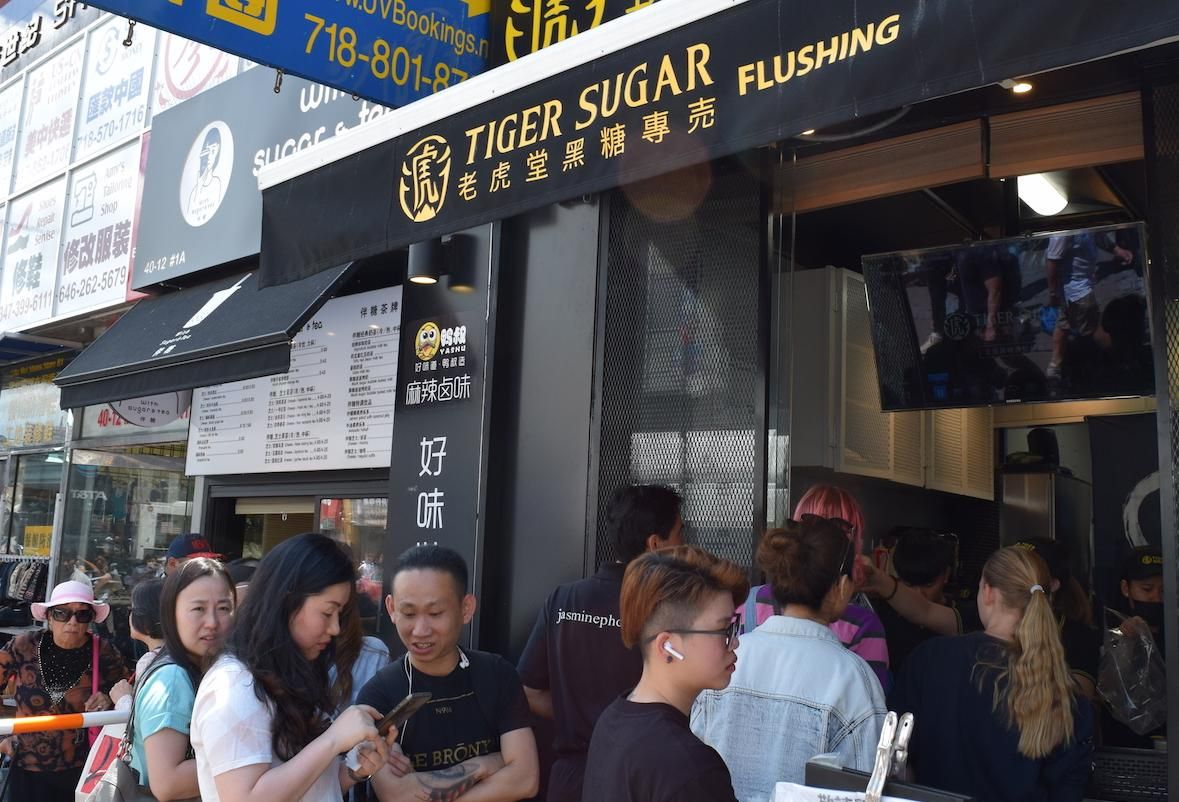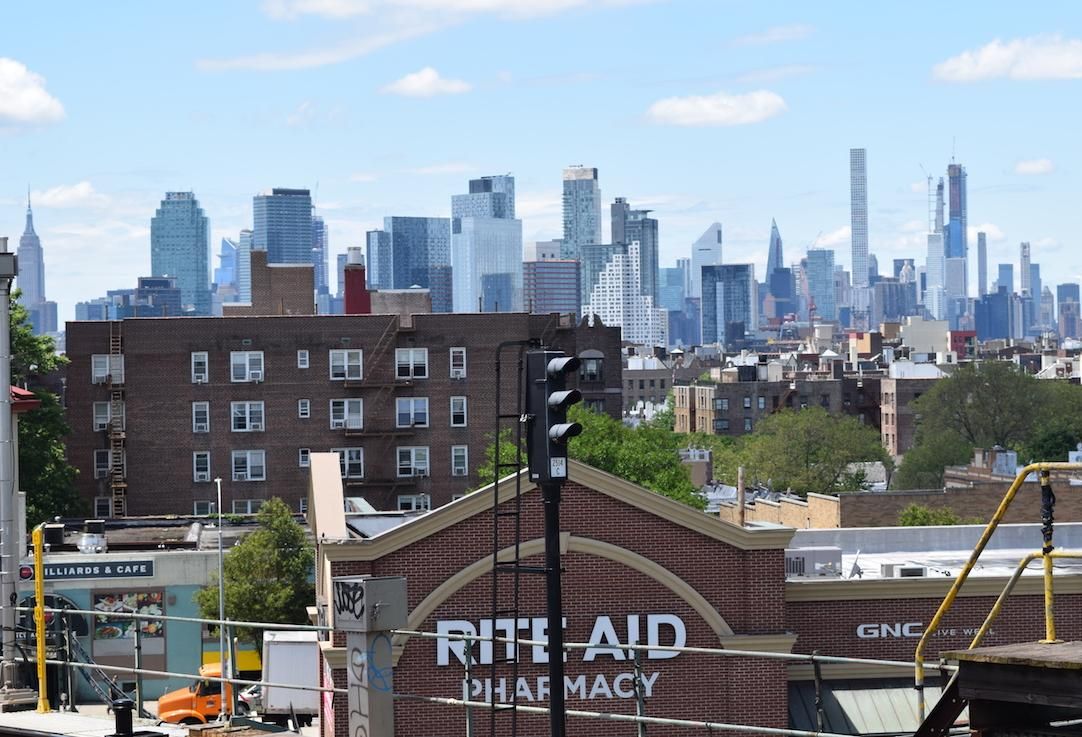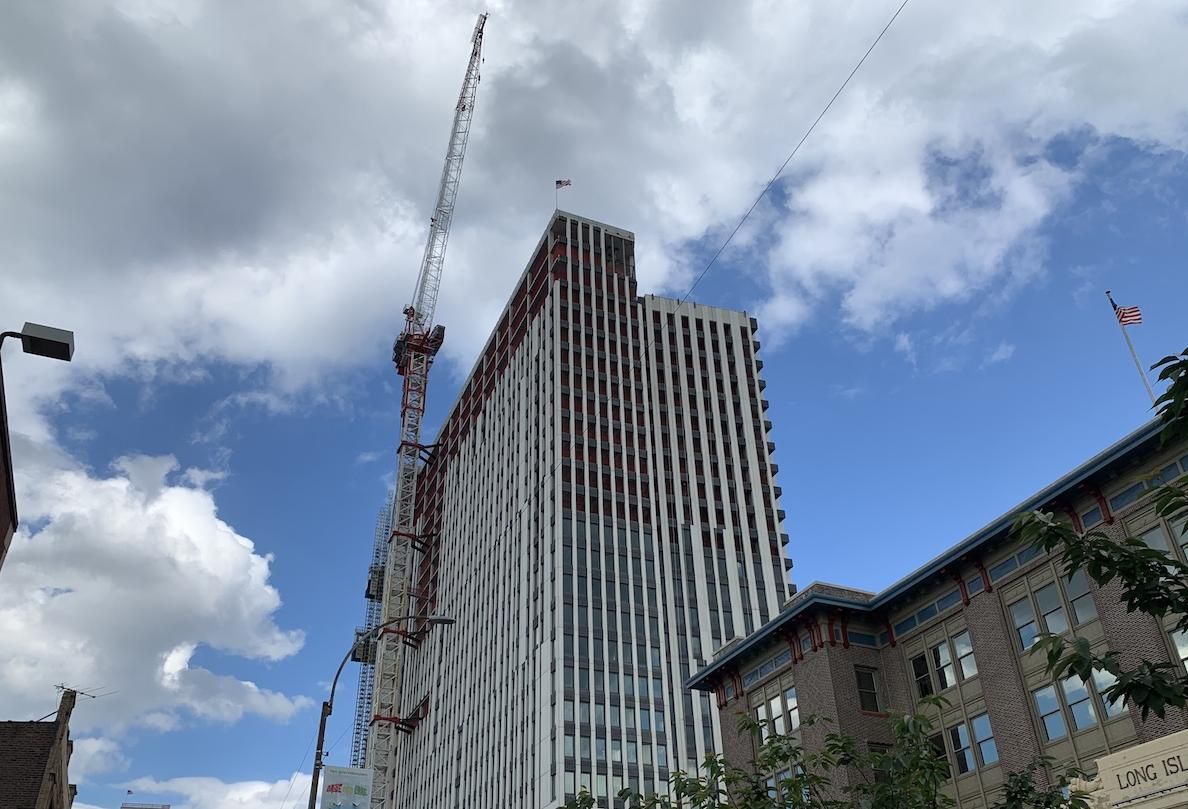October 27, 2021
June 10, 2019
Queens Has Boomed As A Home For Immigrants, And Development Has Followed. What Happens Next?
The line at the new Tiger Sugar Bubble Tea store frequently stretches out the door and down the street. The Taiwanese chain, wildly popular in Asia for its sweet milk and brown sugar drinks, just opened its first North American location earlier this month.
Out on the street, people cut through the bubble tea devotees, darting into grocery stores selling tropical fruits like durian and foods like fish maw, which is used in Chinese soups. The scene may look like an episode from a travel documentary, but it plays out every day just a handful of subway stops from Manhattan's Grand Central Terminal in Flushing, Queens.

In many ways, Flushing — where there are millions of square feet in the development pipeline — is emblematic of the entire borough.
Queens is among the most diverse places in the world. No single racial or ethnic group dominates the population; it is home to half of New York’s Asian Americans, as well as large parts of the city’s Bangladeshi, Filipino, Indian, Korean and Caribbean communities — among others.
Since 1980, thanks to an influx of foreign-born people and New Yorkers escaping expensive parts of Manhattan and Brooklyn, Queens’ population has jumped 25% to reach 2.4 million in 2017, according to a 2018 New York state comptroller report.
Real estate money has followed suit. In Flushing, a 1.2M SF mixed-used development called Tangram (named after a dissection puzzle said to have been invented in China) is now in its second phase — joining a slew of other projects.
“A lot of us are about, like, the hype,” a young woman named Tiffany told Bisnow last week as she was eating lunch at the crowded Queens Crossing Food Court on 39th Avenue. A first-generation American who declined to give her last name, Tiffany said she has lived in Flushing all her life and is thrilled with all the new retail and development that has sprung up over the last few years.
Chasing returns, developers have pushed deeper and deeper into the borough, building vast projects in what were once considered far-flung places like Jamaica, Astoria, East Elmhurst and Far Rockaway.
All the while, the Long Island City skyline has been reshaped with luxury residential high-rises in the past few decades, and many are banking on the borough as a viable alternative to the Manhattan office market, even after Amazon's flip-flop over locating a headquarters campus on the borough's western edge.
Proponents of development welcome the cranes and construction crews, arguing more building is the answer to the worsening housing crisis — and the only way to prepare the borough, and the city, for its ongoing growth.
But like many places in the city, construction has riled some in the community, presenting a unique set of challenges for the builders and developers who are shaping the borough for its next chapter.
“We have major developers, like Tishman Speyer, TF Cornerstone all coming in, but also a lot of developers who started out as maybe an immigrant builder 25 years ago who’s now doing four or five buildings,” Queens Economic Development Corp. Executive Director Seth Bornstein said, adding that the borough needs more affordable housing mixed with market-rate options, as well as commercial space to accommodate the growth of local businesses.
“There's a whole wave, a new generation of development, and any developer needs to be aware of the diversity and how to accommodate that,” he said.
In Flushing, known as Queens’ Chinatown, local developer F&T Group is looking to capitalize on a changing community.
F&T is joining with SCG America to build Tangram, which will ultimately bring 324 luxury condominiums, a 24K SF food hall, a 12-story office tower, a seven-screen movie theater (the first theater in Downtown Flushing in 30 years the developer said) and a 208-key Renaissance Hotel to the area. F&T’s data shows many condo buyers at Tangram have been coming from affluent parts of Manhattan, Queens and Long Island.

Some point to the opening of the Shops at Skyview — a 560K SF retail complex Blackstone Group paid $400M for back in 2015, the firm’s first investment in the area — as a turning point. Right now, the private equity giant is reportedly weighing adding a 30K SF upscale food hall in the building.
“Skyview opening up, that was definitely a big hit. I know a lot of people who go there,” Tiffany said. “There's a lot more stores to shop at, you don't really have to leave Flushing to buy things.”
She had just finished a Spice Bowl — a type of dry mini hotpot from the southwest China province of Sichuan, and was joined by Patrick, a 23-year-old who lives nearby and who also declined to provide his last name. Near their table, a Spanish-speaking family bought towering ice creams from Taiyaki, an Instagrammable, fish-shaped dessert from Japan.
Patrick said he has been coming to shop in Downtown Flushing all his life. He was born in the U.S. after his parents moved from an area outside Shanghai.
“My parents don't speak English, so it is kind of an easy place to communicate and get food,” he said. “Eight years ago there was, like, one mall … now there are stores popping up all around here.”
Much of that development has come from F&T Group, whose previous developments include Queens Crossing and One Fulton Square, a 330K SF mixed-use building, as well as Flushing Commons with AECOM Capital and the Rockefeller Group.
Elsewhere in Flushing, Queens Century Development Group, led by George Xu, is building a 100-unit luxury residential building on 35th Avenue and a 250-room Westin hotel on Northern Boulevard.

“We realized there were a lot of different people coming into the neighborhood, and it’s finally getting the recognition it deserves,” F&T Executive Vice President Helen Lee said in an interview.
Born in Taiwan, Lee moved to Queens at age 6 and speaks of her great sense of pride in the area’s history and culture, and the opportunity to build something in her community. She said she has sought to offer an exciting, fresh development that remains authentic to the area.
In conceiving Tangram, she said, the company took its inspiration from glamorous 24-hour cities like Hong Kong, Shanghai and Tokyo, seeking to create a cosmopolitan, global feeling in Flushing for the next generation of locals and visitors.
“As a Taiwanese American, I think I kind of bring in the West-meet-East type of mentality … It's not just that I'm catering to Asians,” she said. “The world is very global … [I want to] marry all of that, but not make it cheesy.”

On the whole, Queens’ unique diversity and cultural attractions have made it appealing for real estate money for some time now, according to Daniel Tropp, a director at Avison Young’s Tri-State investment sales group who focuses on development.
The average price per buildable square was $228 per SF in the first quarter in 2019, he said, up 8% from 2018. Like most of the city, the investment sales dollar volume has been sliding — development sales totaled $160M in the borough during the first quarter this year, per Avison, a 40% drop year over year. But the number of total sales declined by 64%, indicating to Tropp that prices are going up and larger transactions are taking place; a sign of a healthy market.
What’s more, he said, Long Island City, Jamaica and Astoria are within the city’s top five neighborhoods with the highest number of residential units in the pipeline — more evidence that capital continues to be deployed in the borough.
“Now I’m getting a lot of calls from developers and owners representing either high net worth families, or in some cases institutional capital, looking for $50M to $80M-sized deals in Far Rockaway, to benefit from the opportunity zone [program]," Tropp said. "So that's a pretty new phenomenon.”
Designated zones, which provides a tax break in return for development and investment in underserved communities, cover parts of Jamaica, Long Island City, Jackson Heights and Far Rockaway, to name a few.
The program is viewed as a major boon for investors and developers, but it has also raised questions about the best way the program could improve communities, and what kind of development it should encourage.
Certainly, the word development — regardless of its connection to an opportunity zone — can be a touchy subject for some people who have deep roots in Queens.

Last week in Jamaica, a woman named Debbie was eating lunch. An East Elmhurst local, she traveled to Jamaica to run errands for the day, she said. Her main concern about the future of the borough was whether the construction would create jobs for locals.
“Naturally you want the best for your neighborhood ... We have all got to live somewhere,” she said, adding that she’s "a Queens girl” with Barbadian, Jamaican and Panamanian heritage. "We all have to work together and try to get along."
She worries the development that had been built along Ditmars Boulevard near LaGuardia Airport — a strip where a 1.5-acre development site hit the market earlier this year — hadn’t resulted in jobs for locals at all.
“If somebody, as a developer — I’m talking about a business — comes, then the people in the neighborhood should have first preference for jobs, and [when that doesn’t happen] that really sucks,” she said.
Developers, for their part, argue that if you listen to locals early in the planning process, it will pay off later.
“They may not agree with you at the beginning, but once you provide the data to them and show them what you're doing and get good information rather than sound bites, most people come around," BRP Cos. Managing Partner Meredith Marshall said.
BRP is developing the Crossing at Jamaica Station, a mixed-use complex across from Jamaica Terminal at Archer and Sutphin avenues that will feature 669 affordable units.
He also has two more sites in the works, though construction hasn’t yet started. One is at the corner of Archer Avenue and Guy Brewer Boulevard — which could be home to 1,000 units, Marshall said. The other, at 90-02 168th St., could feature some 600 units and 50K SF of retail. In all, Marshall said his developments will deliver 2,000 units in a five-year span.
Back in 2017, The Greater Jamaica Development Corp. selected BRP to build the project, which is close to Omni Real Estate’s residential development. The area was rezoned in 2007, and the Great Recession meant development there was slow to start.

In 2015, Mayor Bill de Blasio and Queens Borough President Melinda Katz announced the Jamaica Now Action Plan — a $153M plan to support jobs and retail development.
Along with the Crossing, Anchor Green Apartments, a 522-unit apartment building, is being developed by Phoenix Realty Group and Artimus Construction at 147-07 94th Ave. Xu’s Century Development Group filed plans for 90 residential units there back in 2017.
“[There was] no displacement, the community’s on board. By and large, it's great transportation and there's a tremendous workforce within the 1-mile-to-5-mile radius of the development," Marshall said. “So it makes sense for us to go big in Jamaica and the acquisitions were reasonably priced.”
The city, like most urban centers in the U.S., is facing a housing crisis. More than 40% of New York households are rent-burdened, and homelessness in the city is at the highest rate that it has been since the 1930s.
Nearly 62,000 people are in the city’s shelter system, according to the Coalition for the Homeless. Development is often seen as the answer by city planners and business groups, but there has been widespread distrust of developers in recent years.
Marisa Lago, the director of the Department of City Planning and head of the City Planning Commission, said at an industry event earlier this year that anti-development sentiment is now "at an all-time high," and the idea that building actually worsens affordability, which she called a myth, has taken hold.

“There’s a lot of greed,” said Queens-based musician Mackenzie Shivers.
Shivers moved to Sunnyside from the Upper East Side seven years ago with her husband, a decision she said shaved $1,500 off their rent each month. On this particular day, she was running her friend’s vintage store on 46th Street, and pointed to the mix of Turkish, Irish and Armenian communities as to why she loves living in the area.
“It feels like the true New York because it feels truly diverse … [and it is] maybe one of the few places left where I feel like there is sort of a middle-class living,” she said, adding she believes everyone had disliked the idea of Amazon building its HQ2 in the borough, a plan that the tech giant canceled in February.
Not far away from the store, the city has envisioned a plan to deck over the 180-acre Sunnyside rail yards to create what could be up to 24,000 new housing units, including affordable housing, as well as retail, schools and green space, according to a 2017 feasibility study from the Economic Development Council.
The site belongs to the MTA and Amtrak, and is said to be seven times the size of the Hudson Yards site. The proposal is in the master-planning phase, and the city is continuing to run public consultation.

Some community members have expressed fears about the size and scope of the development, worried that it could force renters out of the area. The project’s master planning consulting team has said it is considering six- to 15-story buildings, rather than skyscrapers.
“Queens is very special, and I think that if it got way more expensive and way more crowded, I worry that it will lose a bit of its identity,” Shivers said, adding that the 7 train, already heavily burdened, can’t handle more people.
Slate Property Group co-founder and principal David Schwartz, whose company is developing a 200-unit residential project in Dutch Kills, on the Astoria-Long Island City border, as well as a 170-unit building in Forest Hills, said the diversity and neighborhood feeling of some of the Queens areas are what makes them attractive.
“A lot of Queens hasn’t been touched since the 1960s and 1970s … You know, you walk around Astoria and it feels to me very much like East Williamsburg did 15 years ago,” he said.
Slate will keep looking for development opportunities in areas like Corona, Jamaica, Sunnyside and Woodside — targeting places that allow for density. Schwartz believes there is almost never a positive community response to development.
“They think, 'Oh, you are building to make a developer rich,” he said.
But, he believes, building housing in places like Queens is the only way to maintain its prosperity.
“In Queens you get great food, great culture, all of the things you think about when you think about New York,” he said. “It’s got great infrastructure, really educated interesting diverse people, and I think it's going to just absolutely boom over the next few years.”


